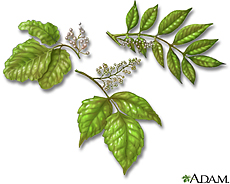 |
 |
 |
Other Health Topics:

-
Related Topics
-
Go Local
- Services and providers for Poison Ivy, Oak and Sumac in the U.S.
-
National Institutes of Health
- The primary NIH organization for research on Poison Ivy, Oak and Sumac is the National Institute of Arthritis and Musculoskeletal and Skin Diseases
If you spend time outdoors, chances are you have been bothered by poison ivy, poison oak or poison sumac at some point. Most people are sensitive to the plants' oily sap. The sap is in the root, stems, leaves and fruit of these plants. If it gets on your skin, it causes a blistering skin rash. The rash can range from mild to severe, depending on how much sap gets on your skin and how sensitive you are to it. Problems can also happen if the plants are burned. Airborne sap-coated soot can get into the eyes, nose, throat and respiratory system.
The best way to avoid the rash is to learn what the plants look like and stay away from them. If you come into contact with the plants, wash your skin and clothing right away. If you develop a rash, ask your pharmacist about over-the-counter medicines. For severe rashes, see your doctor.
National Park Service
-
Poison Ivy(American Academy of Family Physicians)
Also available in Spanish
- Poison Ivy, Oak & Sumac(American Academy of Dermatology)
-
Poison Ivy/Oak/Sumac(Nemours Foundation)
Also available in Spanish
| Basics | Learn More | Multimedia & Cool Tools |
|---|---|---|
| Research | Reference Shelf | For You |
-
Overviews
- Outsmarting Poison Ivy and Other Poisonous Plants(Food and Drug Administration)
- Poison Ivy and its Kin(Dept. of the Interior)
- Poison Ivy Rash(Mayo Foundation for Medical Education and Research)
-
Diagnosis/Symptoms
- Skin Rashes and Other Changes(American Academy of Family Physicians)
-
Treatment
-
Poison Ivy/Oak/Sumac(Nemours Foundation)
Also available in Spanish
-
Poison Ivy/Oak/Sumac(Nemours Foundation)
-
Prevention/Screening
- Poison Ivy: Prevention and Treatment(InteliHealth)
-
Related Issues
- Plants to Avoid: Poison Ivy, Wild Parsnip, and Stinging Nettles, Wood Nettles(Dept. of Agriculture) - Links to PDF
-
Pictures & Photographs
- Poison Ivy, Oak, and Sumac(Logical Images)
-
Journal Articles
References and abstracts from MEDLINE/PubMed (National Library of Medicine)
- Article: Patient education series: poison ivy.
- Article: Black-spot poison ivy.
- Article: Heracleum mantegazzianum and Toxicodendron succedaneum: plants of human health significance...
- Poison Ivy, Oak and Sumac -- see more articles
-
Directories
- Find a Dermatologist(American Academy of Dermatology)
-
Organizations
- American Academy of Dermatology
-
National Institute of Allergy and Infectious Diseases

-
National Institute of Arthritis and Musculoskeletal and Skin Diseases

Also available in Spanish
-
Children
- Poison Ivy(Nemours Foundation)
| Home | Health Topics | Drugs & Supplements | Encyclopedia | Dictionary | News | Directories | Other Resources | |
| Disclaimers | Copyright | Privacy | Accessibility | Quality Guidelines U.S. National Library of Medicine, 8600 Rockville Pike, Bethesda, MD 20894 National Institutes of Health | Department of Health & Human Services |
Date last updated: 02 September 2008 Topic last reviewed: 27 April 2008 |






